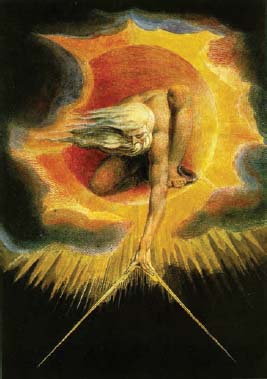Baroque and Beyond C. 1600–1850Romanticism |
Who was William Blake? |
William Blake (1757–1824) was a deeply religious English printmaker, painter, and poet who disliked the formal training of the Royal Academy and spent his career working on highly imaginative projects, including a series of prophetic books modeled after the Bible, which he wrote and illuminated. Blake did not believe in drawing from life, and naturalism was not his goal. He drew on his imagination for visual cues and his works are complex, thematic, and often influenced by the style of medieval manuscripts. He created his own mythology that included characters such as Urizen, a name derived from the phrase, “Your Reason,” who embodies rationality. In one of his most enduring images, The Ancient of Days (1794), which is also often called God Creating the Universe, Blake blends the styles of Michelangelo with medieval iconography to depict the bearded figure of Urizen reaching down from the clouds, his open hand extending into the form of a compass that glows with yellow light from Heaven. While Michelangelo’s images of God are graceful and all-powerful, Blake conceived of Urizen as a complex, negative force, and his The Ancient of Days is bathed in deep red and dark tones. William Blake’s art was not particularly well-received during his lifetime, but garnered much critical attention about a century after his death. He is know considered one of the most important English artists in history—a significant Romantic artist who felt dissatisfied with the promises of the Enlightenment and the values of Neoclassicism.

The British artist William Blake painted The Ancient of Days, a watercolor depiction of a rational God creating the universe with the tools of the architect.
